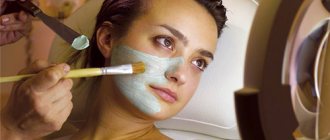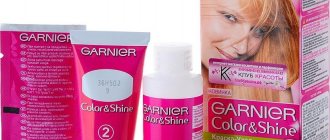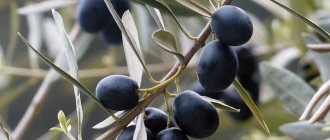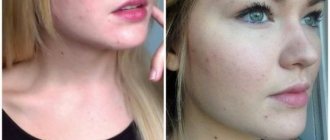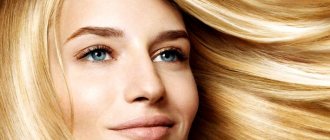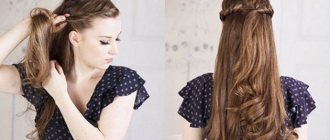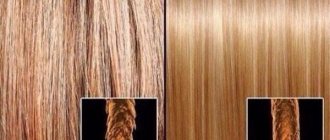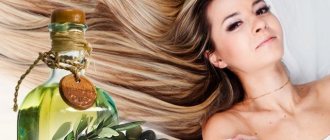Scalp peeling as one of the ways to care for your hair and scalp is absolutely beneficial. During this procedure, the top layer of the epidermis is removed and blood circulation is significantly improved, which leads to cleansing of the scalp, saturation of the hair roots with nutrients, getting rid of dandruff and other diseases. What does it do to your hair? Hair becomes healthy, strong and grows faster. What does this give you, dear girls? Of course, attractiveness, self-confidence and well-groomed appearance.
Variety of means
Having realized that the procedure can improve the health of your hair, you should then figure out how it can be done.
Traditionally used for peeling:
- special gels, shampoos for deep cleansing;
- sea salt;
- black bread;
- essential oils: mint, jojoba, lavender, tea tree;
- Castor oil;
- masks with onions, egg yolk;
- herbal infusions.
These products are actively used when peeling the head at home. Depending on what you choose will determine how deep the peel will be. For example, an onion mask is suitable for light exfoliation, and sea salt is suitable for deep exfoliation.
How to make a choice?
When choosing a specific product, you need to be guided by something. After all, for now this is a simple list, a simple enumeration. That is why we propose to consider how to use each tool, and, more importantly, we will determine what advantages each of them has.
What are the benefits of salt peeling for hair?
Salt is a very common and affordable remedy. Since ancient times, it has been used not only in the kitchen for preparing dishes. Our grandmothers very actively used its beneficial properties in cosmetology. Salt can be found in many products.
Such as:
- body care;
- to strengthen nails;
- to eliminate inflammatory processes on the skin;
- to combat problems such as acne or pimples.
It is no less effective in solving problems with hair growth.
Peeling can help:
- cleanse skin and hair;
- give a feeling of freshness and cleanliness;
- strengthen curls;
- eliminate excess oily hair;
- accelerate their growth.
This effect is possible due to the ability of salt to remove dead epidermal cells and activate blood circulation. Blood intensively flows to the hair follicles, which improves their nutrition and oxygen supply. This makes the strands grow faster, look healthy and shiny.
Peeling with salt has a number of other beneficial qualities. Cleansing dead skin cells helps prevent and treat various scalp problems. This procedure very quickly eliminates dandruff, which is a fairly common occurrence with oily hair or seborrhea. In addition, salt dries skin and hair well and has antibacterial properties.
Regular exfoliation of the scalp with salt leads to:
- accelerating scalp regeneration;
- activation of cellular metabolism of the dermis;
- regularization of fat metabolism;
- normalization of the sebaceous glands;
- reduction of inflammatory processes in the epidermis;
- improving skin tone and health;
- eliminating itching and other unpleasant sensations.
It was noted that after salt peeling, the effect of other beneficial substances is more active. Therefore, such manipulation is often used to prepare for other procedures aimed at treating or restoring hair.
Separately, it should be noted that the specified effect of salt peeling is possible only when used on oily hair. Dry, thin hair will suffer even more from such manipulations; this type of cosmetic procedure is not suitable for them.
Sea salt and more
It is necessary to use medium or fine salt. It is rubbed into the roots of the hair with massage movements for 3-5 minutes, and then, to avoid evaporation and retain heat, put on an insulating cap or, in its absence, a plastic bag or film. Then everything is left for half an hour to achieve the desired effect. After the time has elapsed, wash off the salt with shampoo or apply a mask, and then use shampoo. The second option, apparently, is better.
Salt is applied to dry or damp hair. An analysis of the forum “head peeling reviews” suggests that it is better to apply sea salt to slightly wet hair, since then it does not fall off and is rubbed in quite quickly.
But, whatever you decide, remember: the skin is a delicate structure, and therefore, if you rub salt too intensely, you can scratch the scalp.
If you peel with salt, you can additionally use kefir, yogurt, vegetable oil, or any essential oil. But there are some peculiarities. So, kefir and yogurt can drain from your hair, carrying salt with it, which means the procedure will need to be carried out longer. But oil, on the contrary, will provide the skin with additional nutrition.
Advantages: peeling the head with salt, if you add oil or after the procedure, first apply a mask (purchased or made yourself), and then shampoo, will become not just a way of cleansing, but also a way of nutrition and healing.
Sugar peeling for hair at home
Sugar peeling is the simplest, most affordable and fastest way to get rid of scalp problems. The peeling recipe is very simple:
- shampoo
- sugar
- essential oil
Using a spoon of shampoo, mix three tablespoons of sugar until a paste forms. It is advisable to add a few drops of essential oil or burdock oil to this mass. It is best to use lavender essential oil - it takes excellent care of hair and leaves a wonderful aroma.
After the procedure, the mixture is thoroughly washed from the hair and rinsed with rinse aid. You can make a sugar scrub for your head once a week.
thoroughly rinse off the peeling from your scalp
Brown bread is also good for hair
You will need crusts of black bread. They need to be poured with boiling water and left for several hours. After which the paste should be rubbed into the scalp.
Advantages: if you do a light scalp massage before peeling, which will improve microcirculation, then you will not need to use shampoo after the procedure.
The bread mask not only exfoliates the top layer of skin, but also cleanses the hair. What happens?
- Apply the paste and rub in - this is peeling;
- After this, we leave the bread on the hair for an hour, covering it with polyethylene - this is a mask;
- Then rinse with water (!) - this is the final stage of therapy.
In addition, bread (and this is confirmed by many masks using black bread as a component) in itself is good for hair. And this is another plus.
Effective scalp scrub recipes
Using salt, you can easily and inexpensively make a useful peeling. Take 3 tbsp. salt (preferably sea salt) and stir it in a small amount of water to make a paste. Rub the resulting mass into damp hair roots. It is recommended to do this massage for 10 minutes. Then wash your hair.
To stimulate hair growth, a scrub made from red pepper and cinnamon is suitable. Its preparation will not take much time, and the effect will be noticeable after the first procedure. 2 tbsp. Mix ground red pepper with 2 tbsp. ground cinnamon. Add 1/3 cup sea salt. Stir the ingredients until a thick mixture is obtained. Apply it to a moistened scalp, do a light massage and leave it like that for a few minutes. If a burning sensation occurs, immediately wash off the composition with warm water and do not use it again. Irritation can be prevented with chamomile infusion.
For oily scalp, you can make a peeling based on blue clay. Take dry blue clay powder and salt in a ratio of 1:3. For example, for 1 tbsp. clay take 3 tbsp. salt. Dilute the components with warm water and massage into damp scalp. After 10 minutes, wash your hair with shampoo. You may also be interested in information about what face masks with a lifting effect exist and how they are used.
Video shows hair peeling at home:
You may also be interested in information about how and why a paraffin face mask is made at home.
Mask recipes
Masks for the scalp should be done no more than once every 7-10 days.
- A burdock oil mask nourishes the scalp with vitamins and has a stimulating effect on hair follicles. 1 tbsp. Mix burdock oil thoroughly with egg yolk. Add 1 tbsp. honey and pour in 1 tsp. cognac Mix all this well again. Apply the resulting composition to the scalp and hair. For a better effect, you can wrap your head with something warm. Leave the mask on for 1 hour and then rinse with water. You can see how lifting masks are made at home here.
- A mask made from kefir and henna has strengthening properties . Take 1/2 cup of kefir and heat it to a temperature of 40°C. Add 2 tbsp. colorless henna. Let the mixture sit for about 15 minutes. Then apply the resulting mask and keep it on for 40 minutes. Wash your hair with shampoo. But how to make a mask with the Botox effect and how to apply it correctly is described in detail here.
- Egg masks have strengthening and nourishing properties . Beat the egg until foam forms and pour 100 ml of natural yogurt into it. Distribute the composition proportionally over the entire length of the hair. Leave for 15 minutes and rinse with water. The curls will immediately acquire a vibrant shine, and combing them will become much easier.
- An onion mask will help speed up hair growth. It is enough to grate 1 onion on a fine grater and mix the resulting pulp with 1 tsp. honey Rub your hair with this mixture and rinse after 1 hour. But what a Botox facial mask looks like at home and how effective it is is described here.
- Kefir can solve the problem of quickly oily curls . You need to smear your head with kefir and leave the product on for 1 hour. After this, wash your hair well.
- Cosmetologists call olive oil one of the best remedies for seborrhea, brittleness, and dullness of hair. After using cosmetics based on it, the process of hair growth is accelerated. To prepare the product you will need 1 tsp. squeezed lemon juice and 2 tbsp. olive oil. The liquids must be mixed and heated in a water bath, without bringing to a boil. Gently rub the warm mixture into the scalp and keep warm for 3 hours. After this, wash your hair. You may also be interested in information about what a head peeling mask looks like and how it is made.
It must be remembered that masks and scrubs cannot be used too often. Peels can be used for 1-2 months, and after 1 month the course of procedures can be repeated.
We recommend that you read in more detail about the paraffin hand mask.
Oils: both essential and castor
As already noted, you can choose from the following types of oils: jojoba, tea tree, lavender, peppermint. Because it is they, thanks to their composition, that can produce a peeling effect.
The oil needs to be slightly warmed and rubbed into the scalp in a circular motion. Then cover your hair with polyethylene, and preferably with a towel on top to retain the heat as much as possible. After half an hour, all this is washed off with shampoo. Girls who have used oils, including castor, know well that oil is not washed off very readily. This means that you cannot do without shampoo with this type of peeling.
Benefits: oils are good for hair because their composition is a storehouse of valuable elements.
Masks, infusions, decoctions, or light peeling
All of them cleanse the hair to some extent and have an antibacterial effect. Just in order to enhance this effect, you need to select the appropriate composition, for example, actively include chamomile.
Composition of exfoliating products
Exfoliating products contain components that fight against dandruff and microorganisms that cause fungus. In addition, peelings contain substances that heal the skin of the scalp. The recipes contain plant extracts, algae extracts and famous essential oils - peppermint, tea tree, lavender, jojoba. The composition also includes wheat and rice proteins, glycerin, panthenol, and vitamins.
The cost of such cosmetics can vary - you can find a product for 150 rubles. But high-quality cosmetics for peeling are expensive - from 700 to 1500 rubles.
Try exfoliating your hair regularly - you will see how the sebaceous glands normalize, discomfort will no longer bother you, and your scalp and hair will always be clean and fresh.
